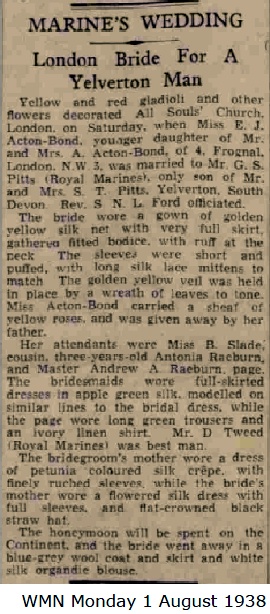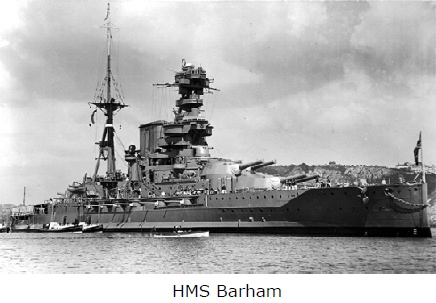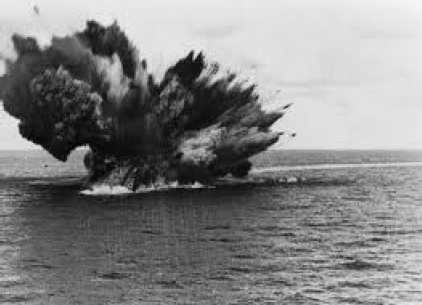G.S. PITTS
George Stanley Pitts was born in Yelverton in January 1914. Only son of Stanley Thomas (1874-1958), corn merchant, and Alice May (1877-2000) of The Cottage, Harrowbeer Lane, Yelverton.
 George joined the Royal Marines after leaving school. In 1935 he was a Lieutenant on HMS Rodney where, as President of the Dance Committee, he organised a ship’s dance at Stonehouse Town Hall in aid of the British Sailors Society. In 1937 he was awarded the King George VI Coronation Medal whilst serving on board HMS Victoria Albert.
George joined the Royal Marines after leaving school. In 1935 he was a Lieutenant on HMS Rodney where, as President of the Dance Committee, he organised a ship’s dance at Stonehouse Town Hall in aid of the British Sailors Society. In 1937 he was awarded the King George VI Coronation Medal whilst serving on board HMS Victoria Albert.
He became engaged to Eve Josephine Acton-Bond, younger daughter of Mrs Acton-Bond of 4, Frogmore Hampstead in January 1938. After a short engagement they married at the end of July in All Souls’ Church, London. After a honeymoon on the Continent they lived in Hampstead where their only daughter, Joanna, was born. He was promoted to Captain on 27 August 1939.
By 1941 he was aboard the 31,000 ton battleship HMS Barham. This ship was commissioned in November 1915 and saw action at the Battle of Jutland. In 1933 she had a refit when her two funnels were shrunk into one. At the beginning of WWII she had several mishaps including a collision, being torpedoed, loosing men overboard and swerving to avoid three torpedoes. In early 1941 she helped sink the cruiser Zara, and took part in numerous coastal bombardments of Bardia, Tripoli etc. Despite a Stuka bomb exploding in her funnel the Barham helped evacuate Crete before going through the Suez Canal for repairs in Durban. In September she returned to Alexadria and bombarded Tripoli again. On 24 November she sailed from Alexandria and the next day was hit by three torpedoes. As she was sinking a fourth explosion occurred as the magazine went up causing the Barham to disintegrate killing 862 men. The next of kin were informed of those missing on 8 December and on 23 December those killed. Captain George Stanley Pitts was among those fatally wounded. It was not until 23 February that a list of those killed was published in The Times. In 1945 the Admiralty released a film of the sinking. In 1957 the HMS Barham Survivors Association was formed.
The Barham was the only battleship sunk by a submarine in WWII.
George is remembered on the Naval Memorial, Portsmouth as well as on the Buckland Memorial at Crapstone and on the framed parchment in St Paul’s Church, Yelverton.
In his will he left his estate of £1284 19s 0d to his widow Eve. His aunt, Kathleen Pitts, was the Principal of St Cyprian’s School, Yelverton.
 In September 2000 his daughter, Joanna Harriet Thomas (nee Pitts) wrote to the HMS Barham Association: “My father went down in the Barham when I was two years old. My mother was so shocked about his death and the violence of war she only went to theSurvivors' Association service once when I was very young; I don't know if I went as well. (She came from a pacifist family). I always knew there was a Book of Remembrance at Westminster Abbey but I could not face asking to see it, though I worked as a tour guide for British Tours and visited Westminster Abbey at least once a week over a year. It is thanks to Joan Dove (the widow of Surgeon Commander Sorley and Sarah O'Donnoghue's grandfather) who lived with us in North Wales before November 1941 and remained in contact and a friend of my mother that I heard of "A Midshipman's War". She sent us a copy. On reading the chapter on the "Barham" it laid some ghosts, I ceased to think of him floating deep in the water, but more at peace. For me it seemed that the torpedoing was random and therefore more acceptable. For the past three years I have attended the Survivors' Association Service at Westminster Abbey, my mother came two years ago. At the Union Jack Club with Sarah O'Donnoghue we met Commander Grogan and George Parker who has written about the "Barham". As a child I remember visiting Connie Cook, Captain Cook's widow she lived in a Mansion flat off Baker Street. She provided me as well as many other people with amongst other things American shoes, brogue lace ups which I can still see. She, I understand, worked tirelessly helping widows and their families. It is her energy which resulted in the collection to provide the candlesticks by the altar in the nave in Westminster Abbey which were carved by Robert Thompson whose symbol was a mouse carved in most of his work. I recently learnt that my mother and a friend Mary Vincent Smith whose husband John was a Doctor in the Navy, spent the evening together with Connie Cook on the day peace was declared. My second cousin Dr Tom Pitts, my father's contemporary, recently told me that once after he retired when he was hospital visiting, a sailor who was on the Barham asked if he was related to my father. He then said that he was the last person to be let through the hatches by my father, before he closed them and the ship exploded.”
In September 2000 his daughter, Joanna Harriet Thomas (nee Pitts) wrote to the HMS Barham Association: “My father went down in the Barham when I was two years old. My mother was so shocked about his death and the violence of war she only went to theSurvivors' Association service once when I was very young; I don't know if I went as well. (She came from a pacifist family). I always knew there was a Book of Remembrance at Westminster Abbey but I could not face asking to see it, though I worked as a tour guide for British Tours and visited Westminster Abbey at least once a week over a year. It is thanks to Joan Dove (the widow of Surgeon Commander Sorley and Sarah O'Donnoghue's grandfather) who lived with us in North Wales before November 1941 and remained in contact and a friend of my mother that I heard of "A Midshipman's War". She sent us a copy. On reading the chapter on the "Barham" it laid some ghosts, I ceased to think of him floating deep in the water, but more at peace. For me it seemed that the torpedoing was random and therefore more acceptable. For the past three years I have attended the Survivors' Association Service at Westminster Abbey, my mother came two years ago. At the Union Jack Club with Sarah O'Donnoghue we met Commander Grogan and George Parker who has written about the "Barham". As a child I remember visiting Connie Cook, Captain Cook's widow she lived in a Mansion flat off Baker Street. She provided me as well as many other people with amongst other things American shoes, brogue lace ups which I can still see. She, I understand, worked tirelessly helping widows and their families. It is her energy which resulted in the collection to provide the candlesticks by the altar in the nave in Westminster Abbey which were carved by Robert Thompson whose symbol was a mouse carved in most of his work. I recently learnt that my mother and a friend Mary Vincent Smith whose husband John was a Doctor in the Navy, spent the evening together with Connie Cook on the day peace was declared. My second cousin Dr Tom Pitts, my father's contemporary, recently told me that once after he retired when he was hospital visiting, a sailor who was on the Barham asked if he was related to my father. He then said that he was the last person to be let through the hatches by my father, before he closed them and the ship exploded.”

